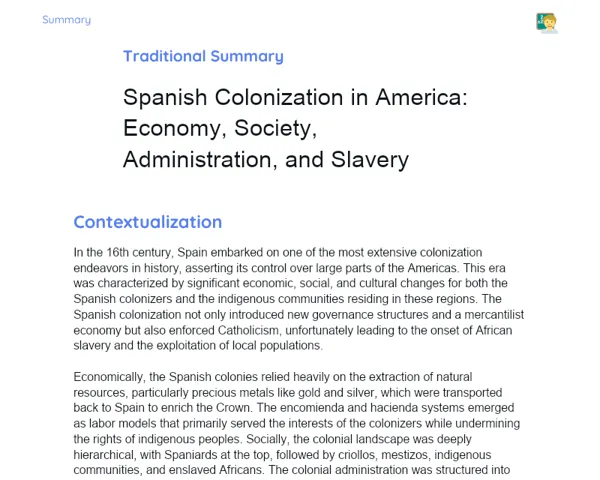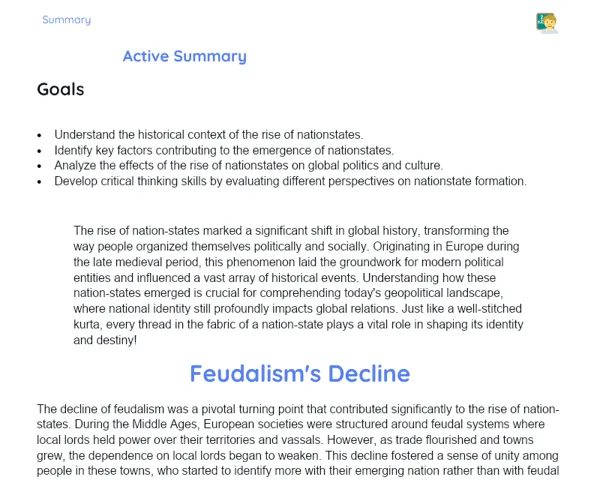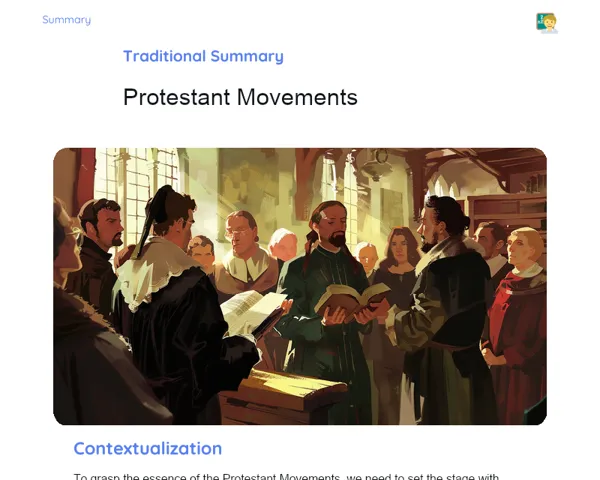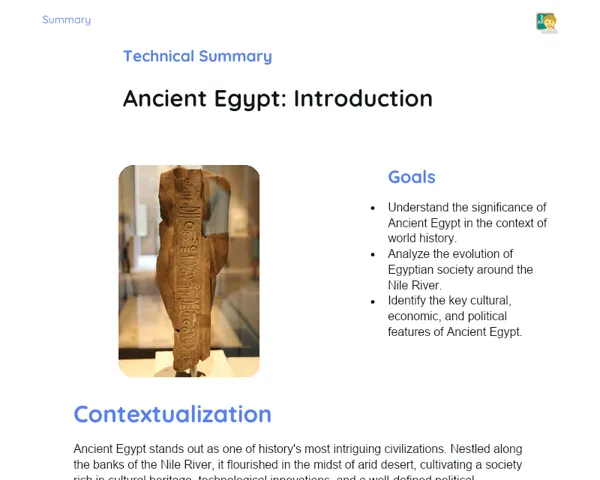Socioemotional Summary Conclusion
Goals
1. Understand the political and social factors that led to the formation of Protestant churches.
2. Analyze how the Catholic Church responded to the Protestant movement.
3. Develop skills like self-awareness and self-control.
4. Explore responsible decision-making and empathy through a historical lens.
Contextualization
🕰️ Imagine living in an era where questioning authority could reshape history! That’s precisely what Martin Luther and other reformers accomplished in the 16th century. Fueled by intense emotions like outrage and a deep sense of justice, they stood up against the powerful Catholic Church, igniting the Protestant Reformation. This movement significantly altered the religious landscape and had a lasting impact on politics and society across Europe. Let's delve into how these emotions and motivations influenced historical events and how we can apply these lessons in our own lives today!
Exercising Your Knowledge
Historical Context
The Protestant Reformation was a religious movement in the 16th century aimed at reforming the Catholic Church. Key figures like Martin Luther, John Calvin, and others challenged practices like the sale of indulgences and nepotism. These reformers were driven by a strong sense of justice and a yearning for change, emotionally charged traits that shaped their actions and the trajectory of history.
-
Corrupt Practices: Issues like the sale of indulgences and nepotism within the Catholic Church generated widespread dissatisfaction, prompting the need for reform.
-
Courageous Leaders: Leaders like Martin Luther boldly confronted the Church's authority, exemplifying courage and a desire to change the status quo.
-
Emotional Impact: The reformers' actions were deeply influenced by their emotional motivations, demonstrating how feelings can lead to significant social change.
Political and Social Factors
Dissatisfaction with corruption in the Catholic Church extended beyond religion. There were also political and social dynamics at play, such as European princes and kings wanting more autonomy. The invention of the printing press further accelerated the spread of reformist ideas, creating an emotionally charged social movement.
-
Political Autonomy: Numerous European rulers supported the Reformation to gain more control over their regions and reduce the Church's influence.
-
Diffusion of Ideas: The printing press enabled the rapid spread of reform ideas, illustrating how new technology can ignite social movements.
-
Collective Emotions: Broad disenchantment with the Catholic Church brought people from various social classes together, highlighting the strength of collective emotions.
Reactions of the Catholic Church
In response to the Protestant challenge, the Catholic Church took vigorous action including internal reforms and repressive measures. The Council of Trent was an early attempt to address these issues and assert the Church's authority. Other measures included the creation of the Society of Jesus (Jesuits) and the Inquisition, reflecting how institutions respond emotionally to perceived threats.
-
Council of Trent: A significant meeting where Church leaders discussed and implemented reforms to remedy perceived corrupt practices.
-
Society of Jesus: Established to bolster the Catholic faith and counter Protestantism through education and missionary work.
-
Inquisition: A mechanism used by the Church to identify and punish those deviating from Catholic orthodoxy, showcasing the emotional intensity of institutional responses.
Key Terms
-
Protestant Reformation: A 16th-century religious movement aimed at reforming the Catholic Church.
-
Martin Luther: German monk whose 95 Theses kick-started the Protestant Reformation.
-
Council of Trent: Assembly of Catholic Church leaders aimed at reforming the institution and tackling Protestantism.
-
Indulgences: The Catholic Church's practice of selling forgiveness of sins, prominently criticized by Luther.
-
Printing Press: An invention that facilitated the swift spread of reformist ideas.
For Reflection
-
How did Martin Luther's emotions of indignation and sense of justice influence his actions during the Protestant Reformation? Can you identify moments in your life where similar emotions guided your decisions?
-
What sentiments and motivations did the princes and kings who backed the Reformation possess? How can these historical examples illuminate the intersection of power and emotion?
-
In what ways does the Catholic Church's emotional response to the Protestant movement, including the Council of Trent and the Inquisition, highlight the importance of understanding and managing both institutional and personal reactions to challenges?
Important Conclusions
-
The Protestant Reformation was a pivotal movement that reshaped the religious, social, and political landscape of Europe in the 16th century.
-
The actions of leaders like Martin Luther, driven by feelings of indignation and justice, directly challenged the authority of the Catholic Church.
-
The printing press was instrumental in disseminating reformist ideas, uniting people from different social strata in a shared movement.
-
The Catholic Church's response involved significant internal reforms and repressive actions, such as the Council of Trent and the Inquisition.
Impacts on Society
The effects of the Protestant Reformation can still be seen today in various aspects of society. Firstly, it fostered greater religious diversity, leading to the rise of different Christian denominations that coexist today. This has nurtured an atmosphere of tolerance and inter-religious dialogue. Secondly, the Reformation stimulated critical thinking and encouraged individuals to read the Scriptures independently, resulting in enhanced literacy and intellectual independence within European societies, and subsequently across the Western world.
In our daily lives, the influence of the Reformation manifests in our interactions with authority and the value we place on freedom of expression. The questioning of norms and the pursuit of justice, which motivated Luther and others, continue to inspire modern social and political movements. Understanding this historical background aids us in acting responsibly and empathetically within our own communities, recognizing and managing the emotions involved in social change.
Dealing with Emotions
To keep practicing the RULER method at home, begin by recognizing your emotions during today's lesson. Perhaps you felt curious, inspired, or even a bit frustrated at times. Understand what caused those feelings: why did you feel that way? Accurately label those emotions. Then, explore suitable ways to express them, whether by writing about them or discussing them with a friend or family members. Finally, effectively manage your emotions—perhaps through deep breathing exercises or keeping a personal journal. This will help you maintain focus and emotional clarity when studying complex topics, such as the Protestant Reformation.
Study Tips
-
✨Review your notes and key points at the end of the day, emphasizing the ideas that resonated with you during the lesson.
-
📚Search for documentaries, films, or series that portray the Protestant Reformation to visualize these events engagingly.
-
🗂️Create flashcards for key terms and historical figures, making it fun to test your knowledge and memorize essential information.



